Beverly Country Club
Illinois, United States of America
Written in August, 2019, you might as well ignore this course profile. Why? Because as we take it ‘live,’ Beverly Country Club is closed for ten months for the final leg of a restoration project that began in the late 1990s. Throughout each stage, the course has been revealed to be something that Bobby Jones and Francis Ouimet knew in 1931: this is a very special Donald Ross course. Tracking the progress that the club has relentlessly made has been gratifying.
When the author first visited in 2002, his expectations were held in check by the drive to the club. Approaching Beverly from downtown Chicago, one passes one crowded, flat city block after another without a hint of promising golf terrain. What awaits the golfer is entirely different and in this way, the course reminds the author of the Inverness Club in Toledo. Founded in 1908, Beverly had its choice of land and picked its present location, which was on the edge of prehistoric Lake Chicago. The front nine is on the north side of what has now become 87th Street and the back to the south.
The second hole plays downhill forty feet from the rim of what was the edge of Lake Chicago into the ancient lake basin. Ross then climbs out of with the approach to the fifth, before sending the golfer back into it at the one shot sixth. The golfer exits for good with the uphill tee ball at the seventh. As for the back nine, it is set across rolling topography that thousands of years ago were sand dunes bordering the lake.
The net result is that the property enjoys ideal movement for golf. To no one’s surprise, Ross came up with a masterful routing within the confines of the two rectangular blocks of land. The holes constantly change directions, which is important when a course is located near ‘The Windy City.’ Though 87th Street divides the property, Ross’s ingenious placement of tees and the angles that he created away from the property lines impress every architecture student. Count people like Ron Whitten and Brad Klein as fans. Ross’s use of the available natural features create a succession of one fine hole after another.
Ron Prichard’s initial restoration work at the start of this century centered around the usual: fell trees to re-establish original playing corridors, re-do the bunkers in a manner consistent with Ross’s work, and expand the putting surfaces closer to the edges of the green pads. All three points were accomplished and Beverly was transformed from a tough, tree-lined course into something more architecturally significant and far more thought provoking to play. A renewed interest in both the course and the club developed and the membership flourished until the 2008 recession.
The course’s potential had been demonstrated and key members agitated for further progress in returning the course to something even closer to its hay-day during the Golden Age of architecture. In 2015, as part of stage two, an additional 500 trees were felled for the purpose of widening the playing corridors and improving the course agronomics via increased light and air flow. As the playing surfaces firmed, so did the demands of the course. Beverly’s reputation became such that it now enjoys a steady influx of younger members sporting single digit handicaps.
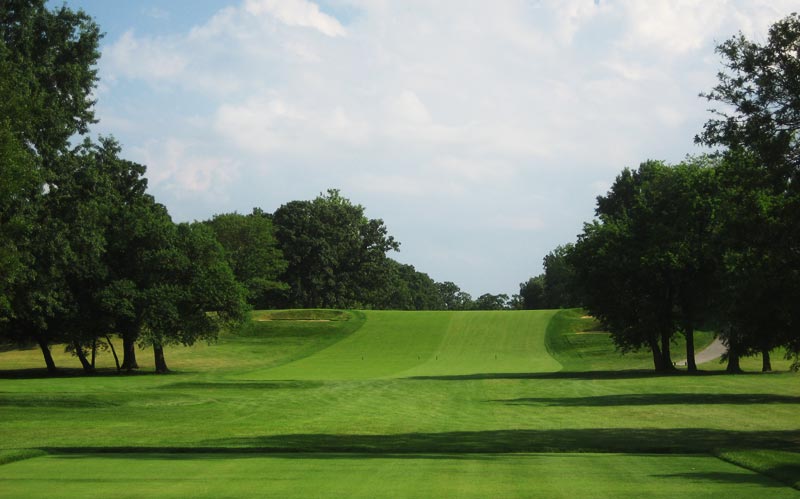
Not all of Chicago is flat! A view from the 7th tee of ‘Heartbreak Hill’ in 2002 and …
The increased attention has only affirmed the direction that the club charted in the late 1990s. Now known as a player’s club, the third and final stage commenced July 30th, 2019. The course was shut, fairways will be expanded, the scale of the bunkers will follow suit, and the greens will be re-grassed and expanded the final 15% to be flush with the edge of every green pad. This remains one of Ron Prichard’s few final personal projects and Tyler Rae will be overseeing the work. The club is in excellent hands and when the course re-opens in the summer of 2020, it will have few rivals in the state as it will have achieved the highest standard in architecture: to be good enough to test the best while still providing enough width and short grass to be fun for all.
To the author, the only conceivably undistinguished hole is the ninth, which was modified to make way for 87th Street years after Ross’s course opened. Other than that, each hole and each shot places an interesting demand on the golfer. With the exception of Pinehurst No. 2, the three weakest holes at Beverly are the equal or superior to any of the weakest holes from any Ross course that the author has seen. The constant demand for good, thoughtful golf at Beverly has long captivated the better golfer.

When stage three is complete, the greens at Beverly will average over 9,000 square feet, making them among the largest in Ross’s portfolio.
The holes themselves are a sturdy lot. Of vital importance though, we need to note that for the two three shotters that measure over 600 yards, there is one that is reachable. For the one shotter that is 245 yards, there is a short one. Several very fine sub-400 yard two shotters balance the pair over 440 yards. With every question being posed of the golfer by this mix of holes, the golfer is not surprised to learn that Beverly’s roster of champions is second to none. Francis Ouimet triumphed in the 1931 U.S. Amateur and Jack Nicklaus won the 1967 Western Open here. Additionally, Chick Evans, Arnold Palmer, and Virginia hero Marvin ‘Vinny’ Giles have emerged victorious as well. Most recently, Beverly hosted the 2014 Western Amateur which featured many players currently on tour. Beau Hossler prevailed over Xander Schauffele 2-up. Also in the field were Bryson DeChambeau and Doug Ghim, who shot a 63 to set a new competitive course record that previously was held by Tom Weiskopf. We see why the course produces such champions below.
Holes to Note
Please note: two distances are provided below, one from the 7,016 yard championship markers and one from the more reasonable 6,563 yard white tees.
Second hole, 580/535 yards; Beverly’s collection of the three shot holes is among the dozen or so finest in the Ross family as they are so diverse. The second is downhill and features more bunkers than any other hole. The seventh is the opposite as it plays starkly uphill, the eleventh falls over rolling ground and the dogleg right Home hole features one of the course’s most severe greens. In the case of the second, it offers great insight into the steady progress made this century.
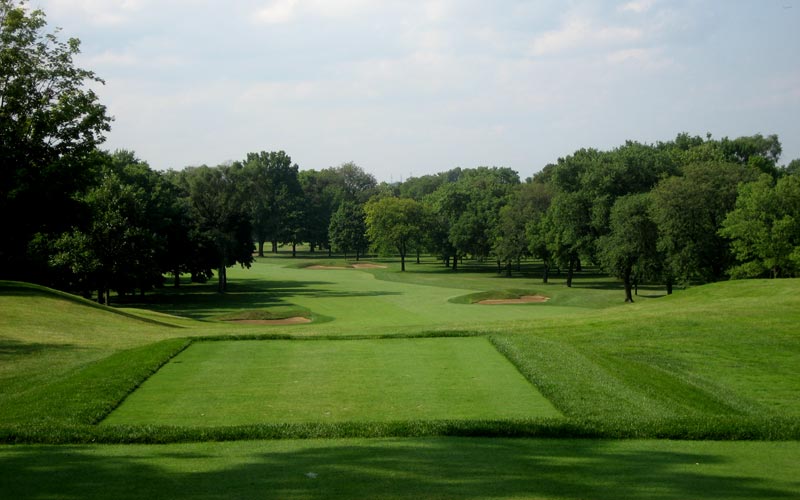
In 2002, the GCA.com profile read, ‘Ron Prichard and Beverly Country Club deserve credit for the sensitive tree removal program that they have accomplished to date. However, as seen from the second tee, a bit more remains to be done. The big tree on the inside of the dogleg should come out as well as the tree in front of the second bunker ahead on the right.’

Move forward to 2019 and the board, backed by the members, had the gumption to aggressively open up the landscape quite a bit more with the stage two tree removal. Now, the bunkers are out of scale with their surrounds. Based on studying old aerials, it was determined that the first left fairway bunker was in fact twice (!) as big in the 1930s. That brings us to stage three that just got underway whereby the fairway and bunkers will be returned to their original, expansive sizes.
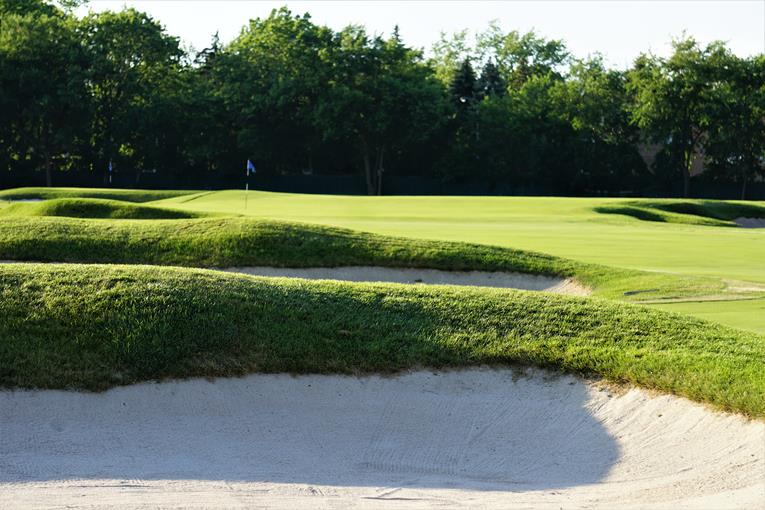
After the 2019/2020 work, golfers that carry this string of bunkers will once again find fairway and be able to properly access the back right hole locations. Angled and 35 paces deep, this is one of the course’s best greens but its playing angles and possibilities had never been fully realized. Its transformation over 20 years epitomizes how Beverly will have gone from telling the golfer what to do to asking if the golfer can figure what he should do – and that is a spectacularly more interesting question!
Fourth hole, 400/385 yards; Some members consider this dogleg left their least favorite hole on the course, which indicates just how strong the rest of the holes are. They grumble that the dogleg is a bit too severe and they have trouble squeezing the desired birdie from the hole. To the author, this kind of problematic hole – one that cries for prudence from the tee by hitting less than driver – should be celebrated, not chastised. Remembering that the property is rectangular in nature, straight holes proliferate. Only this hole, the aforementioned modified ninth, and the Home hole are doglegs. Therefore, the risk reward question posed from this tee is an unusual one. Does one take a mighty swing directly toward the green or should he play a hybrid to the outside corner and play position golf? It is a fine – and important – question to be thrown into the mix.

The bunker on the inside of the dogleg left is only 200 yards to carry, which leads some to reach for their driver and aim well left over the trees.
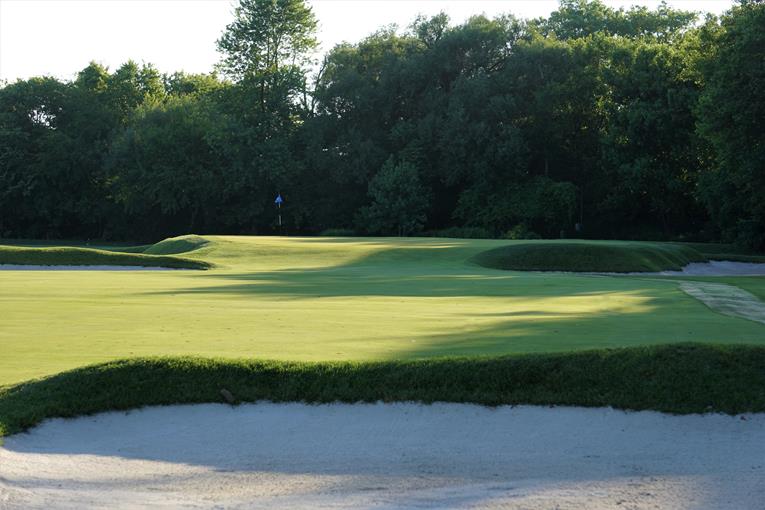
A well placed 230 yard drive from the tee leaves this enticing approach shot. The challenge from the built-up green pad is simple yet few modern architects seem content to build such a ‘clean’ green complex.

Mounds acting as a back wall plague modern designs and it is refreshing to find a green not so framed.
Fifth hole, 415/400 yards; What percentage of Ross holes either start or finish on a hole’s high spot? There is no telling but it would be high. Take Beverly for example: The first green, second tee, fourth green, fifth green, sixth tee and eighth green are all prime examples on the front nine. Here, the golfer confronts the day’s most uphill approach and judging it correctly is no mean feat, especially as the golfer has just spent the past thirty minutes playing in the flat lake basin.
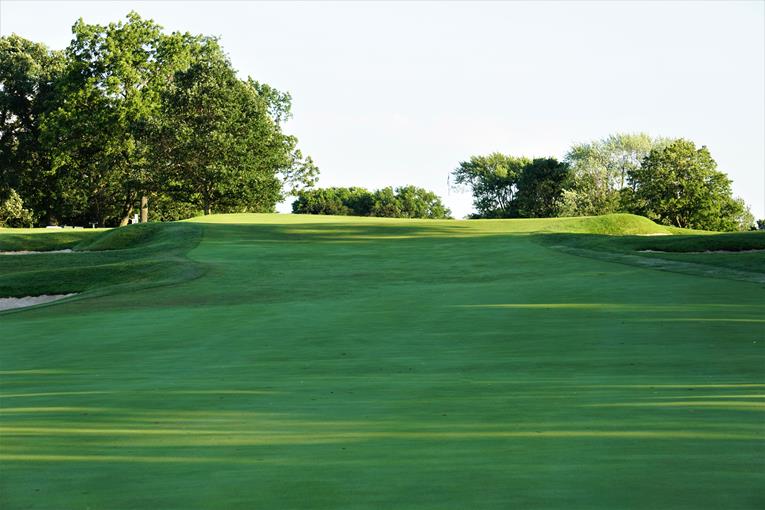
Where there is an elevated Ross green, warning flares should go off in the golfer’s mind to stay beneath the hole.
Sixth hole, 190/170 yards; Maximising the predominant natural feature available, Ross placed the tee on the edge of the rim of the extinct lake and the golfer stares down at another push up green ringed by bunkers. The elevated tee combined with the wind that gives Chicago its moniker means that only a well controlled tee ball finds the target. Since the ask appears straightforward, the golfer is surprised to learn that this hole tends to play among the two or three highest relative to par in events when such statistics are kept.

The 6th green has always been an elusive target. In 2019, it sits in an open field with the 2nd and 4th flags/greens clearly visible beyond. In 2020, a sea of tan fescue will be beyond the green, blowing in the breeze while providing texture and contrast.

In 2006, it was ringed by trees but the bunkers had been restored and the putting surface had been expanded around the perimeter.
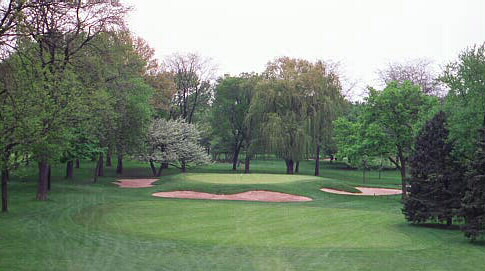
In 2000, the general shot requirement was the hole’s only redeeming quality.
Eighth hole, 425/405 yards; Relating to the green expansions, Prichard faced an interesting dilemma here at the eighth, which was one-third its present size in Ross’s day. In preparation for hosting the 1963 Western Open, the green was dramatically expanded forward and now measures a whopping sixty-five yards (!) from front to back. The angle of the green coupled with the graceful slope at its back affords a number of interesting hole locations. While Ross never designed a green remotely similar to it, the present day green has great golf qualities. In the end, Prichard wisely opted to leave the green its full size. It works wonderfully well, with the front left and back right hole locations being among the most vexing on the course.

The course’s most deceiving approach shot was created in 2002 when Prichard restored a central hazard to the fairway. It might look like it snuggles up against the green but in fact, the green doesn’t commence for 40 paces.
Eleventh hole, 605/570 yards; The golfer now enters the best portion of the property and stays on it for the rest of the round. Additionally, Ross kicks into high gear on some of the green complexes, building exotic back knobs and wings in some instances. Take this one for instance, which comes at the end of one of the longest holes in Chicago. The green falls over seven feet from the high back left knob to the lower front right. As part of stage three, the knob will once again be made part of the putting surface. Starting in 2020, golfers will be able to use the knob to their advantage as a backboard to access back left and back middle hole locations. It is an important fun element that will soon be part of the equation again at Beverly, both here and at the fourteenth. No one has ever doubted Beverly’s toughness, but when adjectives like ‘creativity’ and ‘fun’ get added into the equation, Beverly rises to an altogether higher plateau.
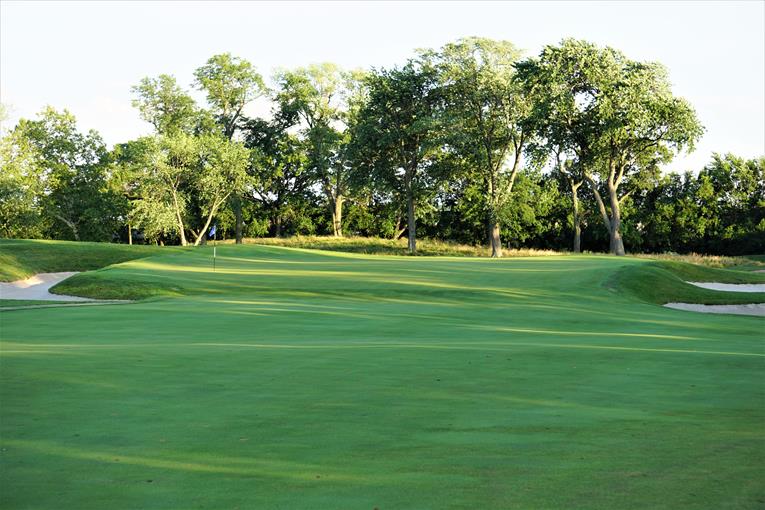
The high back left corner will soon be part of the green again, opening up a myriad of possible options for the thinking golfer.
Twelfth hole, 165/140 yards; The pitch of the green coupled with the idyllic pond remind the golfer of another oft-photographed Ross one shotter: the third at Pine Needles. Prichard regained the original depth of the five greenside bunkers in 2002, giving this hole additional menace beyond its challenging putting surface. In 2019/2020, Tyler Rae and he will be extending the green front left to recover the dramatic front left hole location that was used in the 1931 U.S. Amateur.

The far back left and right hole locations are particularly difficult as the green slopes away at its rear corners.
Thirteenth hole, 385/375 yards; Sometimes it is just as important as to what a club hasn’t done as to what it has done. In the case of Beverly, several blind tee shots exist and it would have been easy to have altered one or more of them over the past 70 years. Mercifully, apart from one hillock at eleven that Ross advised should be lowered, they never have. The easiest one to have altered in recent times ‘for the sake of fairness’ would have been this one, whereby the tee ball must clear an abrupt hill 80 yards in front of the tee. By not doing so, the golfer is all the more keenly aware of the property’s exceptional movement. In fact, Beverly is presently considering suppressing, or lowering, several tees to aid in one’s appreciation of the rolling topography.
Fourteenth hole, 335/325 yards; Beverly is famous for its big finish from fifteen in, so the pair of sub-400 yard holes at thirteen and fourteen that parallel each other take on added significance. To butcher them is tantamount to not playing to your handicap. And both holes are about to get even better as a series of attractive bunkers are being placed between the two fairways and any slight pull will likely find punishment with complacency being the undoing of any golfer who steps onto the tee of either hole without a clear attack plan. At the fourteenth, should the golfer lay back from the tee to avoid the fairway bunkers to the left and right that protect the 100 yard mark? Should he slot his drive between the two bunkers and be left with his trusty 54 degree wedge? Should he drive past the fairway bunkers and get as close to the green as possible? Part of the answer lies with the day’s hole location – the golfer must be able to control his approach, keeping it below the hole at all costs on this steeply pitched green.

Ross flared up the back right corner of the green, in a similar fashion to what he did back left on eleven. Once again, this knob is going to be recaptured within the confines of the green, thus re-introducing the age old thrill of hitting to Point A to end up at Point B. This will become one of Beverly’s best known holes when stage three is complete.
Fifteenth hole, 465/455 yards; Ross laid this tumbling two shotter over the small dunes that once sat above Chicago Lake and suffice to say, Ross’s construction technique did nothing to harm them. Rather, his routing captured the rise and fall to perfection within the playing corridor. The golfer is amazed to find such ‘links’ topography, especially after his drive to the Club.
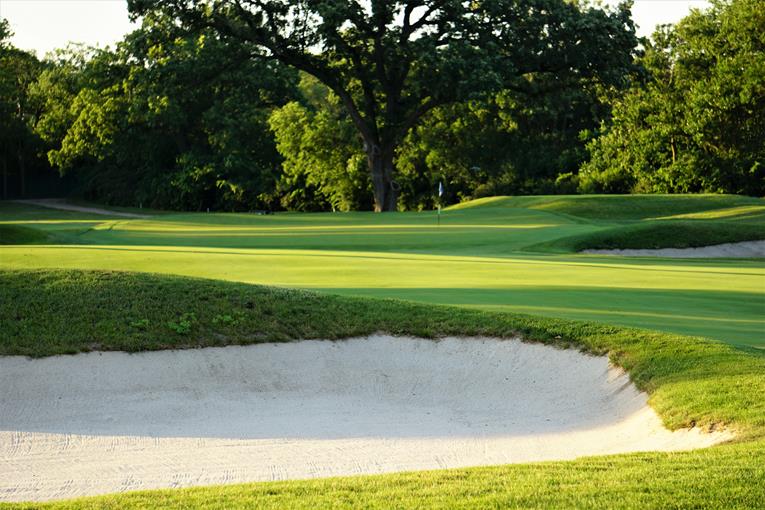
Ross wisely left the green open in front of the longest two shotter at Beverly. Beware of the false front.
Sixteenth hole, 440/405 yards; Variety is the cornerstone of any great design, that much is known. Explaining what constitutes it is more problematic. Here, the slightly downhill approach to the open fifteenth green is followed by an uphill approach at sixteen that must carry past a pair of sentinel fronting bunkers. The golfer can tick back through the holes to develop an understanding of how Beverly’s alternating shot requirements lead it to score high in variety. Remember the modest length thirteenth and fourteenth holes? The first one is blind off the tee with an uphill short iron approach while the next is downhill with everything in plain view. The list of rotating challenges goes on and on.
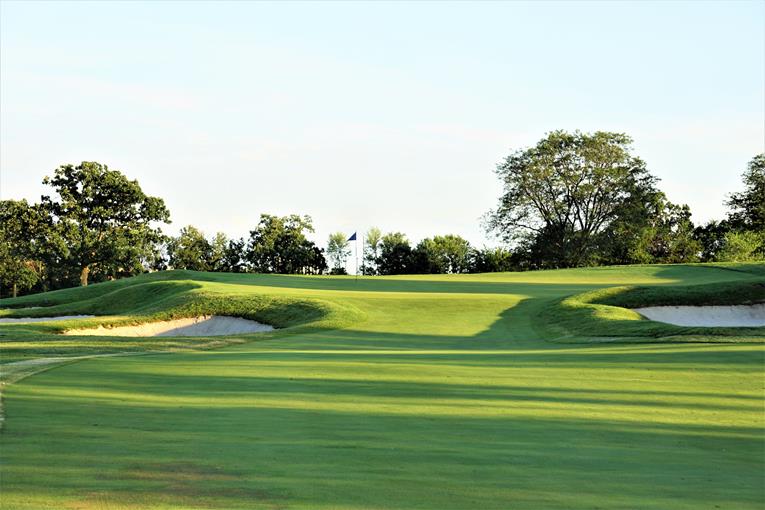
Given that the green is the ultimate target, the more attractive and varied the green complexes, the better the course. Note the punchbowl qualities around the back right of this green and how handsomely Ross benched it into the right hillside.
Seventeenth hole, 230/200 yards; Too many features on modern courses only reward raw power with the need to display precision having been lost. That simply isn’t true at Beverly, where the operating margin can be surprisingly small. The penultimate hole is a prime example whereby a hole that looks innocuous becomes a terror based on the day’s hole location. This hog-backed green is pitched from back to front and a putt from 25 feet above the hole is devastatingly more difficult than a 50 foot chip from just short. Ross’s greens make the course a study in positional golf, with its members enjoying a huge playing advantage over first time guests.
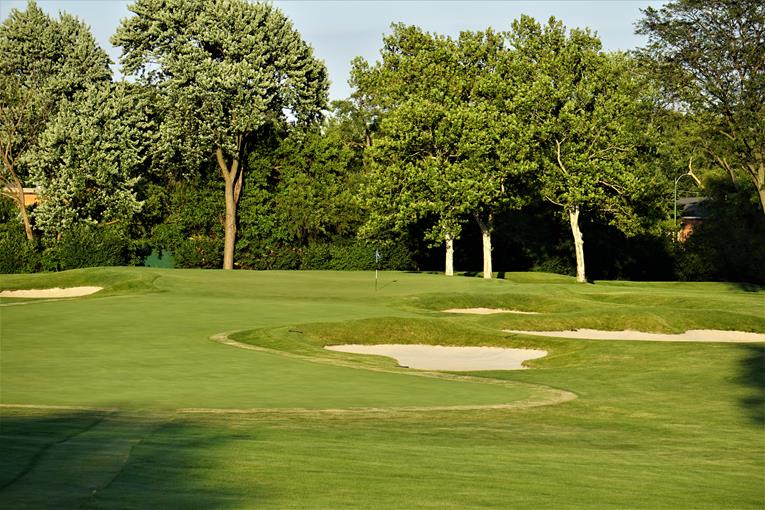
Beautifully presented, the golfer readily discerns the day’s shot requirement. Can he hit the required fade that bounces just short of the green, climbs the false front, and peels right to the hole? Many a golfer is painfully reminded that ‘seeing’ and ‘doing’ are two different things. The author witnessed a putt from the back of this green to the day’s hole location above be effortlessly escorted off the front.
The landforms are such that the property is a delight to stroll and the club readily embraces a walking culture by emphasizing its caddie program. Beverly is a major supporter of the Western Golf Association’s Evans Scholars Foundation; more caddies from Beverly have received the Evans Scholarship than from any other club in the country.
Beverly was extremely well regarded within the Ross family of courses when it hosted the 1931 U.S. Amateur. The good player has long been attracted to its exemplary routing and the strength of its challenge. As Prichard’s Master Plan is fully adopted and reaches its conclusion, Beverly is once again commanding similar respect and attention. Is it deserved? Yes, because once Ross’s clever design is fully revealed, it will be that rarest of breeds: an enthralling examination of physical skill and mental agility in a peaceful setting.
Stay tuned for a fall 2020 update on what will end up being one of Chicago’s three or four finest courses.
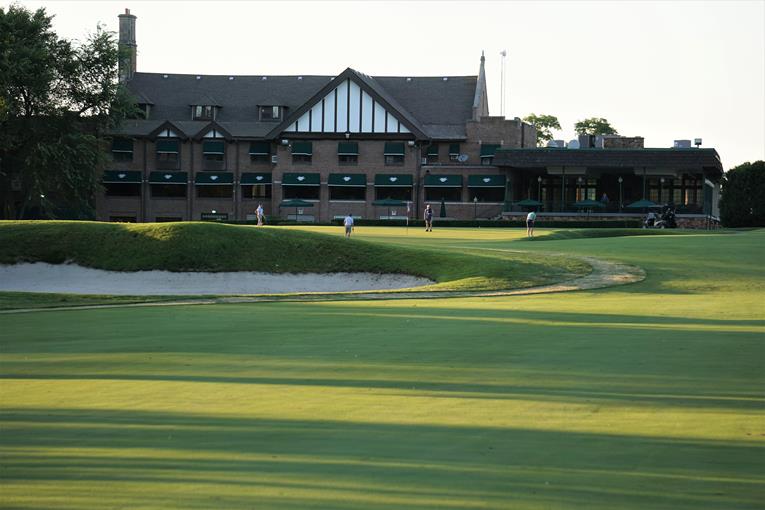
Beverly poses the same degree of challenge today that it did in 1931 when Francis Ouimet and Bob Jones happily chatted beneath the clubhouse.


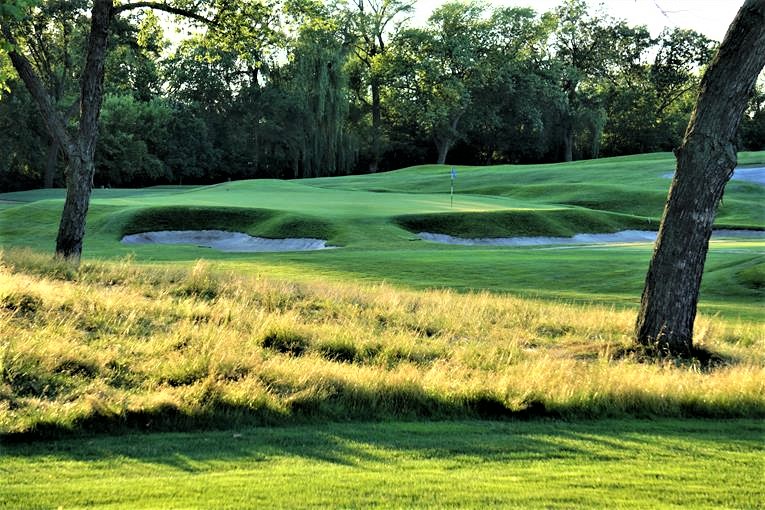
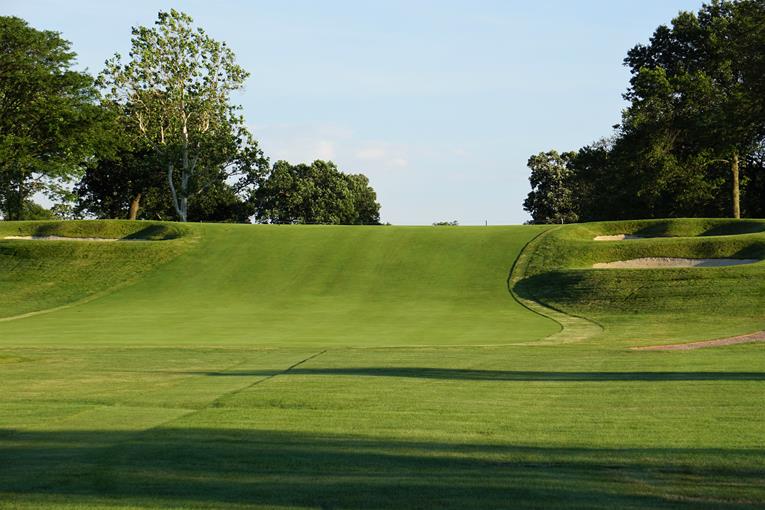
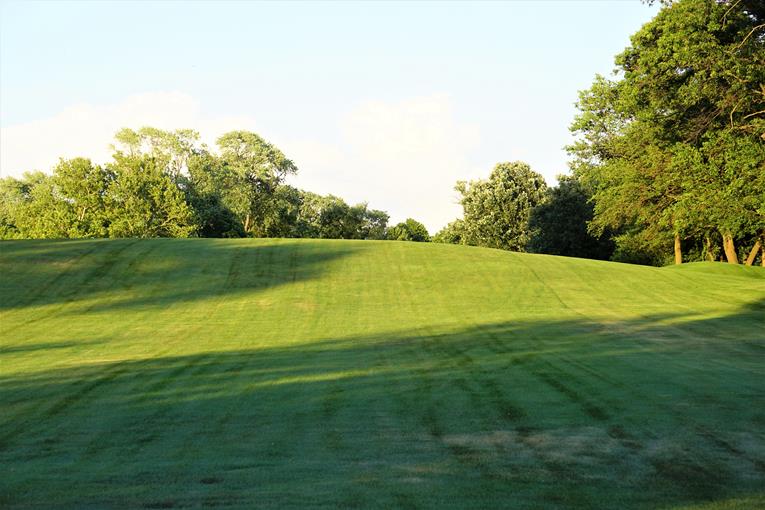




![The Park, West Palm (Lit 9) [2023]](https://golfclubatlas.com/wp-content/uploads/2024/12/IMG_7092-2-scaled-500x383.jpg)


